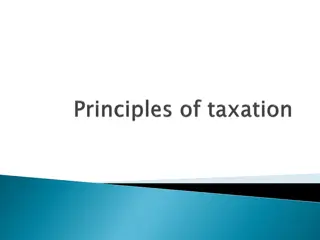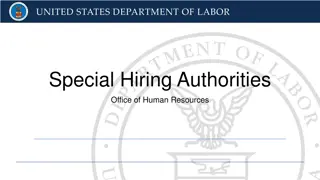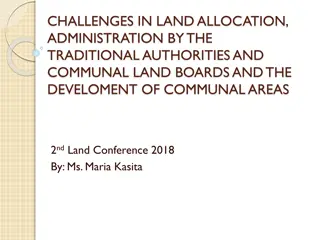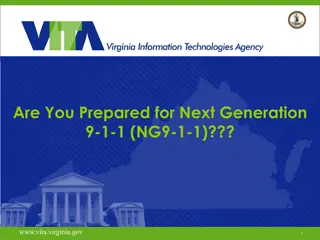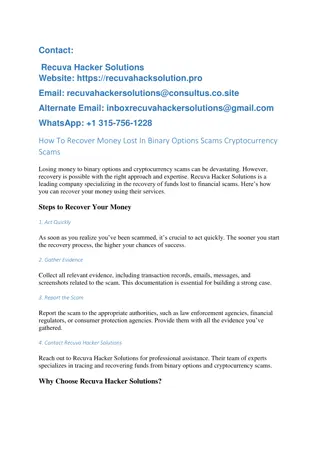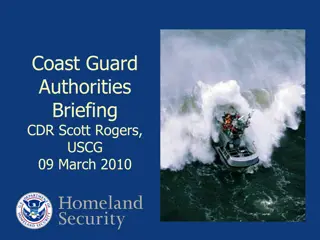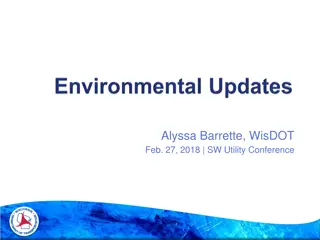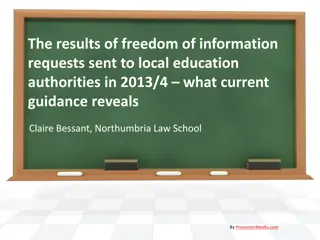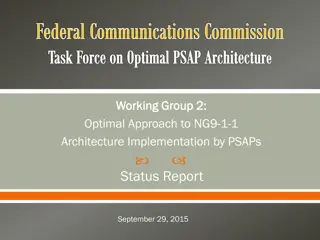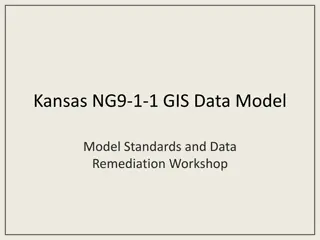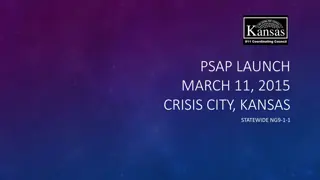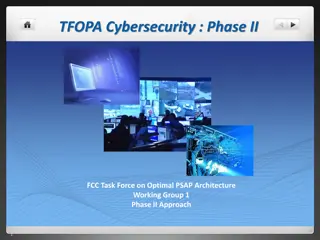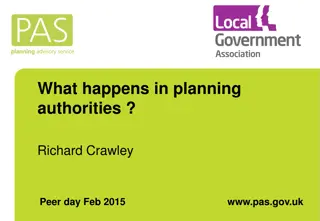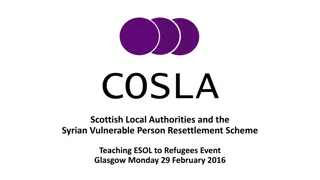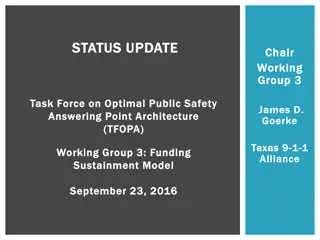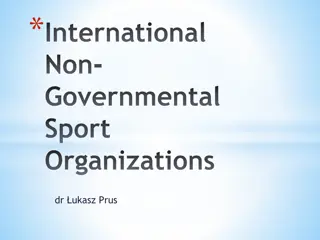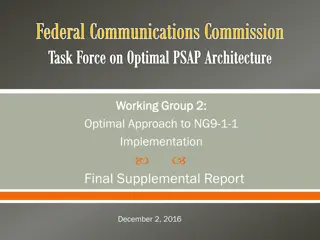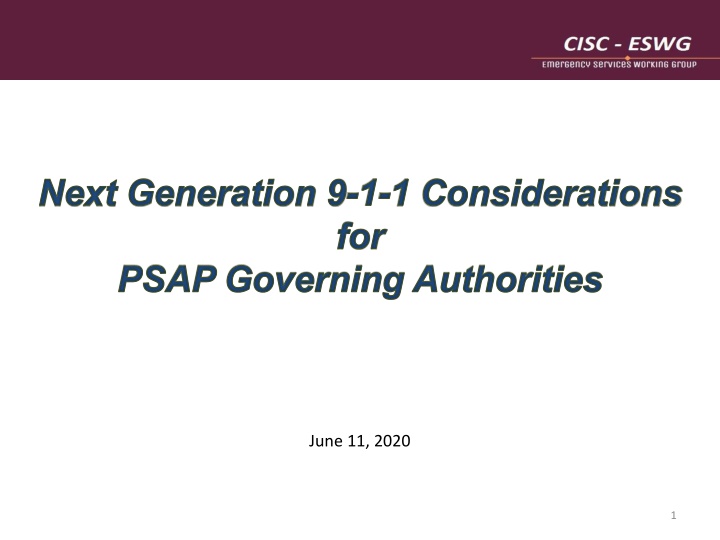
NG9-1-1 Considerations for PSAP Governing Authorities
This document provides valuable insights into the Next Generation 9-1-1 (NG9-1-1) transition, highlighting the importance, impacts, and timelines involved. It outlines the national implementation process, emphasizing the need for immediate action and stakeholder engagement. PSAPs and governing authorities are urged to start planning, budgeting, and resource allocation for a successful NG9-1-1 transition. The article emphasizes the necessity for coordination, collaboration, and proactive measures to ensure a smooth transition to the enhanced emergency services ecosystem.
Uploaded on | 0 Views
Download Presentation

Please find below an Image/Link to download the presentation.
The content on the website is provided AS IS for your information and personal use only. It may not be sold, licensed, or shared on other websites without obtaining consent from the author. If you encounter any issues during the download, it is possible that the publisher has removed the file from their server.
You are allowed to download the files provided on this website for personal or commercial use, subject to the condition that they are used lawfully. All files are the property of their respective owners.
The content on the website is provided AS IS for your information and personal use only. It may not be sold, licensed, or shared on other websites without obtaining consent from the author.
E N D
Presentation Transcript
Next Generation 9-1-1 Considerations for PSAP Governing Authorities June 11, 2020 1
Introduction What is Next Generation 9-1-1? NG9-1-1 is a replacement of the current Enhanced 9-1-1 infrastructure and systems. Why is NG9-1-1 so Important? The current 9-1-1 system has reached end of life, and cannot keep up with evolving technologies OR public expectations of a modern 9-1-1 system. NG9-1-1 is not just about new technology. It provides enhanced situational awareness and new opportunities for collaboration and transformational change in 9-1-1 service delivery and emergency services operations. Impacts and Timelines? Starting today, the entire 9-1-1 emergency services ecosystem, including 9-1-1 communications and dispatch / operations for police, fire, and EMS, is affected. Immediate Action? Stakeholder engagement, technical and operational needs assessments, funding, and coordinated planning must start now. 2
National NG9-1-1 Implementation Process CRTC NG9-1-1 Regulatory Policy / Approved Standards Decision 2017-182 mandates Telephone Service Providers (TSPs) to: Establish NG9-1-1 voice-capable networks by March 30th2021* Establish real-time text (RTT) capability by March 30th2022*, and Decommission the legacy 9-1-1 network by March 30, 2024*. Decision 2018-188 by the Commission confirms that NG9-1-1 related connections will include secondary PSAPs in future NG9-1-1 network access tariffs. To ensure all participants move to an NG9-1-1 ecosystem in a coordinated fashion, the standards-based NENA i3 Architecture is the NG9-1-1 standard that will be followed in Canada based on CRTC Decision 2015-531. The CRTC ESWG continues to work on the evolving NG9-1-1 standards and best practices to assist PSAPs and Governing Authorities with the multi-year transition logistics. * Updated dates per CRTC Letter Direction (8 April 2020) pending proceeding to confirm 3
What does this mean for PSAPs and 9-1-1Governing Authorities? Status quo is NOT an option and timelines are very short. NG9-1-1 voice rollout starting in April 2021 (coordination not required) Coordinated NG9-1-1 text (aka Real-Time Text) implementation by Province/Territory is planned for April 2022 to February 2024. NOW is the time to raise the red flag with agency authorities and engage your 9-1-1 service provider. PSAP management and authorities must start planning and budgeting for NG9-1-1 NOW. Business assessments, gap analysis, and transformation planning is required NOW. Resource planning both human and capital - is required NOW. PSAPs and authoritative stakeholders need to engage with NG9-1-1 solution providers and equipment vendor, to strategically and cost-effectively design and support NG9-1-1 transition and implementation. Legislation, standards, training, policies and procedures, and new roles and responsibilities will need to be reviewed, defined, amended and implemented in time for the NG9-1-1 transition and implementation. The transition will be gradual but intense for a significant period of time (1 to 5+ years). 4
Mandated NG9-1-1 Transition Timelines (v2) NG9-1-1 Voice Network Ready (TSPs) March 30, 2021 ILECs decommission legacy 9-1-1 networks March 30, 2024 Roadmap PSAPs can begin onboarding to provide NG9-1-1 Voice April 2021 (Coordination not required) All PSAPs must be migrated to the NG9-1-1 network before March 30, 2024 CRTC Decision 2017-182 IMPORTANT: Timelines Adjusted per April 2020 CRTC Letter NG9-1-1 Text Messaging (RTT) Ready - March 30, 2022 All TSPs to be NG9-1-1 compliant before March 30, 2024 Coordinated PSAP Launch of NG9-1-1 Text Messaging (RTT) Apr 2022 Feb 2024 NG9-1-1 Preparations & Trials Feb 28, 2018 to Mar 1, 2021 (RTT trials continue after voice trials) New NG9-1-1 Services (future): including Additional Data + new Services and Media 2018 2019 2020 2021 2022 2023 2024 2025 2017 Initial NG9-1-1 Cost Studies and Tariffs March 2021 TSP tariff and standards activities that inter-relate to PSAP Activities Final NG9-1-1 Cost Studies and Tariffs March 2024 NG9-1-1 Text Messaging Interconnection Requirements Sept 2021 Ongoing ESWG activities to support the transition to NG9-1-1 Legend: Purple denotes CRTC decisions, deadlines & Telecommunications Service Provider Obligations (TSP) Green denotes the start of the PSAP onboarding process Red denotes vital PSAP activities June 11, 2020
Key Strategic Action Plan Activities Determine, assess, and plan for business transformation needs. See the Action Plan (attached) Develop a change management strategy, especially related to call handling and IS/IT resources. Develop a 5-year (minimum) strategic roadmap envisioning your Provincial/Territorial end-to-end 9-1-1 emergency response ecosystem that includes NG9-1-1 data and service capabilities. Develop an NG9-1-1 governance and emergency services delivery model. Work with PSAP partners to update MOUs and coordinate training delivery to ensure a coordinated, logical rollout of NG9-1-1 in your Province/Territory. PSAPs and their governing authorities should work with provincial / territorial governments to create or amend 9-1-1 legislation based on NG9-1-1 impacts. Understand and action the information being provided by ESWG. This is a paradigm shift in which innovation and improvement opportunities need to be considered for a modern, efficient and effective 9-1-1 emergency services delivery model. 6
Cost and Resource Implications Determine, assess, and plan resource requirements (human & capital) for major 9-1-1 infrastructure and operational upgrades and changes. Identify new roles and responsibilities for both technical and operations staff that considers initial and future-state NG9-1-1 environments. Determine, assess, and plan procurement requirements. Identify existing and new funding sources for short, medium, and long- term NG9-1-1 and related emergency response ecosystem capabilities. Define a sustainable future-state 9-1-1 emergency services delivery model. New funding requirements, evolving cost information, short timelines, and scarce/new specialized expertise requires action and planning now. 7
Technology Considerations Determine, assess, and plan for the following: New options for NG9-1-1 compliant call handling equipment on site, managed and/or hosted services From a closed system to a secure IP network From analog to IP-based multi-media communications Use of open standards Systems integration and interface upgrade requirements (e.g. Phone, Logging, CAD) New data about the call, the caller and the location (providing much better situational awareness) New mapping standards and requirements (GIS) New logging, storage, retention, and disclosure requirements New collaboration and coordination opportunities Develop a technology plan for the new call handling requirements; define best practices for presenting and managing the NG9-1-1 features and functions. Develop methods to ensure a secure environment: Cybersecurity (hackers, intrusion detection, cyber terrorism, data protection) Reliability, resiliency, and redundancy Physical security Specialized NG9-1-1 technical expertise is scarce, yet PSAP technologies and processes need to be assessed and possibly upgraded, overhauled, redesigned and/or replaced to meet public and CRTC expectations of a PSAP in a modern NG9-1-1 emergency services ecosystem. 8
In Summary PSAPs and their governing authorities must engage with their 9-1-1 network providers and industry stakeholders to PLAN, FUND, and EXECUTE the technological and operational changes required for an effective transition between NOW and February 2024. Coordinated NG9-1-1 implementation by Province/ Territory is critical to ensure that the expectations of the public, 9-1-1 stakeholders, and the CRTC are met. Stakeholders need to envision, plan, and execute work to establish a NEW, world-class 9-1-1 emergency services ecosystem. 9


